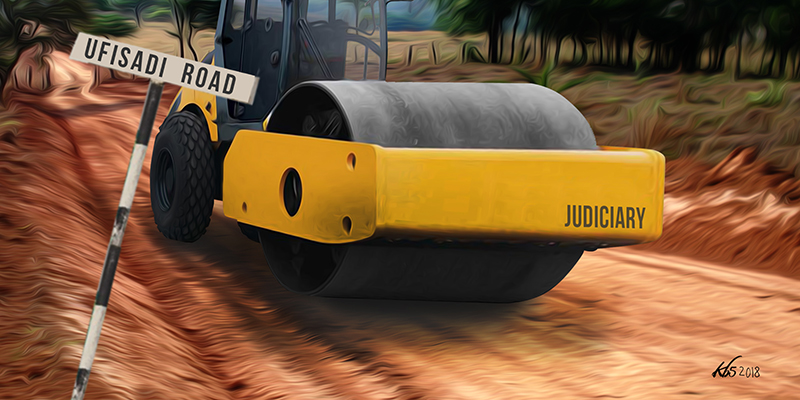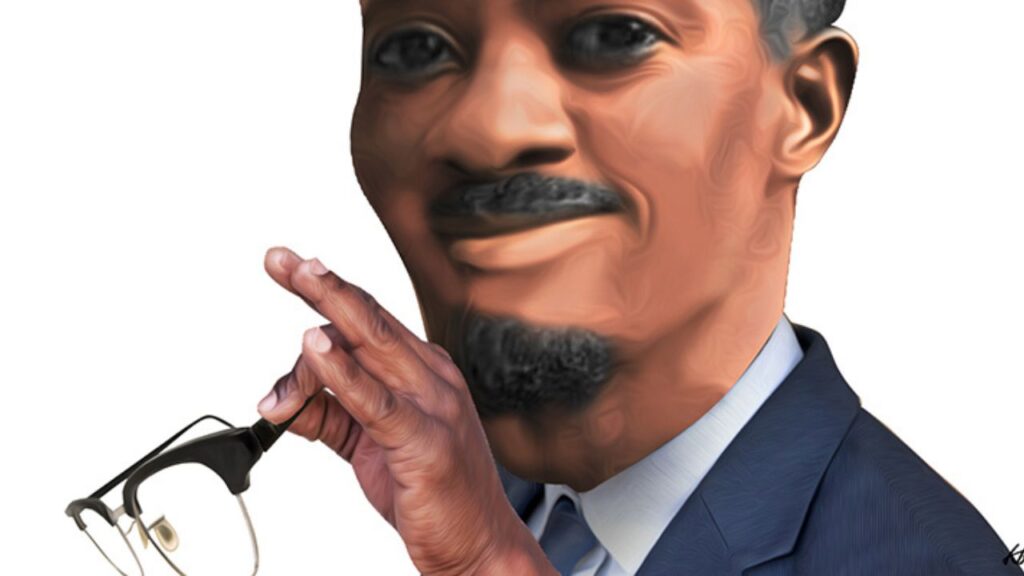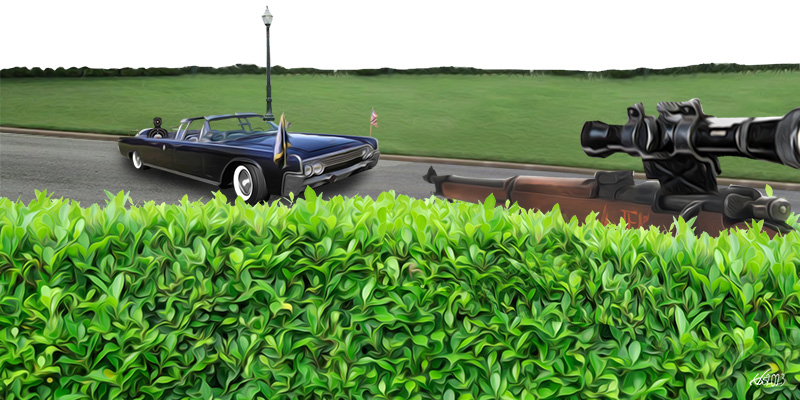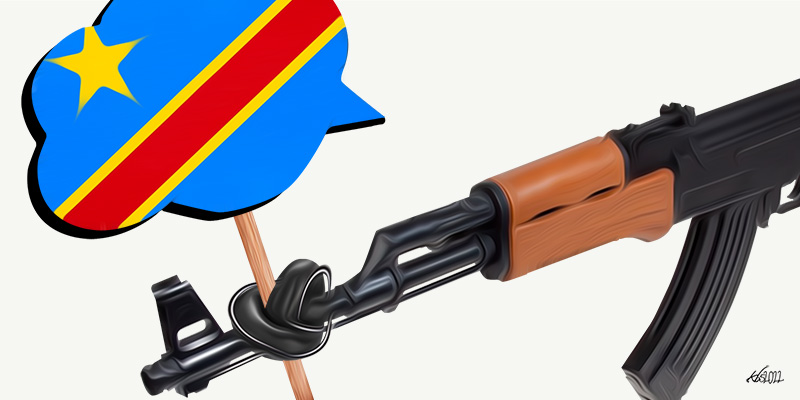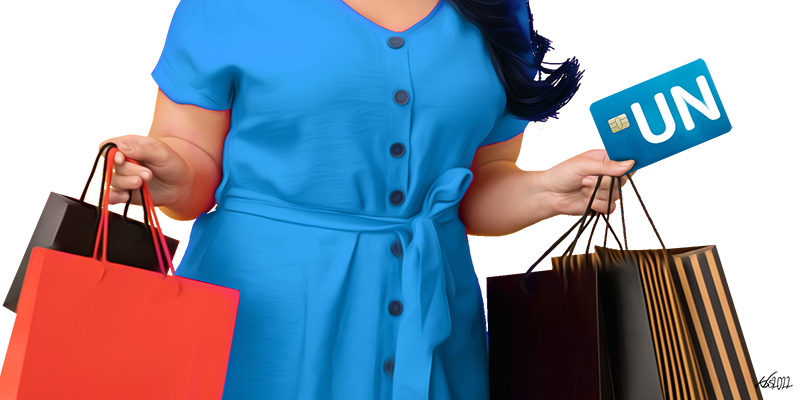Independence Day
On the morning of 1 September 2017, Kenya entered the annals of history as only the fourth country in the world to annul a presidential election. Before that, courts in only Ukraine, the Maldives and Austria had annulled presidential elections. No opposition party in Africa had ever successfully petitioned a court to overturn an election, and the decision was praised globally as striking a blow for democracy and the rule of law. “Look, in view of all that evidence, and in good conscience, what other decision would I have made and how would I have looked?” the Chief Justice remarked.
Outside the courtroom later, as the majority decision and the two dissenting opinions were read out and broadcast live, the crowds erupted into celebration. From inside the building, it felt as if a bomb had gone off.
The judiciary had finally come of age, judicial independence had been attained. In the days that followed, judicial officers discussed on their social media pages how they were retaking their oaths of office. Erstwhile critics in the Internet fever swamps were suddenly gushing with praise for the judiciary.
President Uhuru Kenyatta was visibly angry. He had expected the court challenge on his victory to suffer the same fate as the challenge to his 2013 election victory and plans for his swearing in were already in top gear. The day before the Supreme Court decision Kenyatta had even made disparaging remarks about waiting for what some six people would decide regarding the election, and a false news alert on the Kenyatta family-owned K24 TV had implied that the petitioners had lost the case even before the judgment had come in. The 2017 petition was expected to go the same way. Then it all went horribly wrong.
Kenyatta had waged many battles in courts both at home and abroad and he had prevailed each and every time. He had defeated petitions seeking to stop his candidacy for president, neutered efforts to invalidate his shocking 2013 presidential election victory, and watched with amusement as a crimes against humanity case against him at the International Criminal Court (ICC) floundered, with witnesses withdrawing or recanting their testimony. He had won every court battle that mattered – until then.
Just what had changed in four short years? The answers would become clear from the actions undertaken in response to the petition decision.
Kenyatta’s first response to the Supreme Court’s decision annulling the election was to make a televised address from State House pledging adherence to the rule of law (sic). Later on the same day, he let rip at a rally of his supporters at Burma Market in Nairobi, calling the judges crooks and warning the Chief Justice that now that his victory had been invalidated, he, the Chief Justice, would be dealing with a President and not a mere president-elect.
Still smarting, Kenyatta told a State House meeting the following day that the country had a problem in the judiciary and vowed he would fix it.
Maraga thinks he can overturn the will of the people,” Kenyatta said. “We shall show you in 60 days that the will of the people cannot be overturned by one or two individuals. Tutarudi na tukishamaliza tuta-revisit hii mambo yenu …Tunafanya kazi hii, unakuja unablock, unaweka injunction. Kwani unafikiria wewe umechaguliwa na nani? [After we return from the repeat election, we shall revisit your issues. We cannot be working only for you to frustrate us with injunctions. Who do you think elected you?]
The tirade signalled the beginning of a political onslaught that would manifestly challenge the judiciary’s claim to independence.
Among Kenyatta’s supporters, the anger was palpable. And it quickly turned into action – Member of Parliament for Nyeri Town Ngunjiri Wambugu petitioned the Judicial Service Commission (JSC) to remove Chief Justice Maraga from office for alleged gross misconduct. He accused the Chief Justice of instituting a “judicial coup” with a view to seizing political power. The petition to the JSC came only a day after Members of Parliament from Kenyatta’s Jubilee Party announced during a Senate debate that they planned to pass a series of laws to limit the powers of the judiciary on elections. Kenyatta prevailed on Ngunjiri to withdraw the petition.
Within a week, a loud demonstration by Jubilee Party supporters was accompanying Derrick Malika Ngumu to the Supreme Court as he lodged a petition with the JSC to remove Justices Mwilu and Lenaola from office. The petition accused the two judges of gross misconduct and breach of the judicial code of conduct for allegedly being in contact with the petitioner’s lawyers during the hearing of the 8 August presidential election petition. As it turned out, cell data showed that some of the judges lived within the same radius as a bar popular with politicians. The JSC dismissed the petition for lack of merit.
In contrast, when the decision to annul the election results came in, Raila Odinga and Kalonzo Musyoka were in court. From the court steps, Odinga declared that the decision had vindicated him and he pressed his advantage by demanding resignations at the electoral commission as well as irreducible minimum reforms to guarantee a free fresh election. He would later withdraw from the fresh election and call on his supporters to boycott it.
Both Kenyatta’s and Odinga’s reactions to the nullification appeared to be knee-jerk and tactical rather than strategic. The nullification appears to have surprised both protagonists, with the result that they were grappling with how to deal with loss and victory, respectively. As the court drank in the praise for its courage and independence, the attacks against some of its judges began to crystallise. The opposition began to expect more decisions along the same lines, and the angry government saw the court as a stalking horse for the opposition that might well issue more damaging decisions if not checked.
The decision to annul the election results was a huge rebuke to the electoral commission’s conduct, but it stopped short of finding the commissioners and staff culpable
The majority judges had not thought that they were in any danger. They were convinced of the soundness of their decisions and how they had arrived at them; they felt that they could defend them. After all, they had not cited Kenyatta for anything untoward. Although the judges understood the President’s anger for what it was — a normal human reaction, they took comfort in the public support that they received. Yet, that public goodwill lulled them into underestimating the hostility they were going to face.
The decision to annul the election results was a huge rebuke to the electoral commission’s conduct, but it stopped short of finding the commissioners and staff culpable. The commission’s chairman invited the director of public prosecutions to investigate any of his staff suspected of wrongdoing. Save for a few low-level officials at the polling station and constituency level who allegedly tampered with the elections, no charges have been preferred for illegal acts committed in the 8 August 2017 polls.
Because the judges had not faulted the President or any individuals at the Independent Electoral and Boundaries Commission (IEBC) despite acknowledging the existence of “irregularities and illegalities”, they felt safe since they had not crossed the invisible line of power.
Still, there was a surge of attacks on the judiciary. Public demonstrations against the Supreme Court judges took place in Nyeri, Eldoret and Nairobi. The demonstrations targeted the Chief Justice in particular, with some protestors burning his effigy. Within the public sphere, an explosion of coordinated fake news, hash tags, videos and social media postings targeted the judges and the courts. Kenyatta’s reference to the judges as wakora [crooks] spawned the hash tag #WakoraNetwork.
On 19 September 2017, a day before the judges were due to deliver the reasons for the determination in the petition, the Chief Justice stood on the steps of the Supreme Court flanked by members of the Judicial Service Commission.
He pointedly criticised the Inspector General of Police, who he said was not taking judges’ calls. Judges had requested increased security but they were being ignored. “If leaders are tired of having a strong and independent judiciary, they should call a referendum and abolish it altogether. Before that happens the judiciary will continue to discharge its mandate in accordance with the Constitution and individual oaths of office,” he said.
The judges had never faced as much pressure as they did in the aftermath of the decision; they had no experience in dealing with the executive at close range, and nothing could have prepared them for the backlash.
It was a sobering moment as the Chief Justice said that he was willing to pay the ultimate price to protect the Constitution. Maraga was considered an insider, beloved by entrenched interests who hoped that he would apply the brakes on the reforms train, but he had little experience in playing the long game with the executive and the legislature.
The constant attacks were eroding whatever social capital the Supreme Court had built up with the decision of the 1st of September. As public support for the Supreme Court grew lukewarm, dampened by politicians’ criticism of the judges as having gone rogue, so too did the spirit that had imbued the court before the election nullification begin to wither.
By the 1st of October, when Supplementary Budget Estimates were published to accommodate the costs of the fresh presidential election, the budget of the judiciary had been slashed by Sh1.95 billion or 11.1 per cent.
At the height of emotions over the Supreme Court’s annulment decision, the ruling coalition demanded that changes be made to the Judicial Service Act to modify the procedures concerning the appointment of judges. The National Assembly passed amendments to the Election Act barring the courts from opening ballot boxes to scrutinise voting tallies
The judiciary’s budget had previously been increasing progressively from Sh3 billion in 2009/10 to Sh7.5 billion in 2011/12 before reaching a high of Sh16 billion in 2015/16. As other sectors continued to receive increased budgetary allocations, the judiciary’s projected budget of Sh31 billion was slashed to Sh17.3 billion.
At the height of emotions over the Supreme Court’s annulment decision, the ruling coalition demanded that changes be made to the Judicial Service Act to modify the procedures concerning the appointment of judges. The National Assembly passed amendments to the Election Act barring the courts from opening ballot boxes to scrutinise voting tallies.
A shaken IEBC was so uncertain of itself that it filed a petition seeking the Supreme Court’s advice on its role in verifying election results. The court ruled in its 17 October advisory opinion on what it had said in its September judgment, that the IEBC chairman could not correct errors on the vote tallying forms.
As the year wound down, the Kenyan Section of the International Commission of Jurists named CJ Maraga as 2017 Jurist of the Year, celebrating his courage in leading the Supreme Court to the majority decision to annul the presidential election result.
In the aftermath of the fresh election, the dismantling of the president’s legal team would give an indication of the depth of Kenyatta’s disappointment in those handling his legal affairs. Solicitor General Njee Muturi was demoted to Deputy Chief of Staff at State House; AG Githu Muigai would suddenly resign in January 2019, and the president’s advisor on constitutional affairs, Abdikadir Mohamed, would decline a posting to South Korea as ambassador. The president also accepted the resignation of Keriako Tobiko as Director of Public Prosecutions and offered him the position of Cabinet Secretary for the Environment.
Within the judiciary, there was a collective sigh of relief that the institution’s prestige and honour had been restored. The joyous mood at the Supreme Court contrasted sharply with the ugly scenes in the aftermath of the 2013 decision on the presidential election petition. As soon as Chief Justice Willy Mutunga had read out the 30 March 2013 decision, each judge swiftly left the building under the escort of the paramilitary General Service Unit (GSU) and the crowds in the streets were dispersed with teargas. What had begun as a globally watched court battle ended in silent ignominy. Much hope had been placed on the Supreme Court in 2013 and the disappointment in its decision significantly injured the public standing of the judiciary.
Just what had happened to change the Supreme Court in the four years between 2013 and 2017?
The 60-day period the Supreme Court gave for a fresh election provided a snapshot of the judiciary’s highest moment as an independent institution. The judiciary had for years been engaged in a struggle to claim its independence within a volatile political environment. The interplay of internal institutional politics – involving appointments, personality clashes, conflicts of interest and opposing judicial philosophies – and the external politics around how those wielding political power related with the institution is likely to have influenced how the court decided the presidential election petitions in 2013 and 2017.
Court in A New Mould
Kenya’s first Supreme Court was cobbled together from the old judiciary, academia, and civil society and it is instructive that the Court of Appeal contributed only one judge to the new apex court that would topple it in the judicial hierarchy. It was a clean break with the insularity of the Court of Appeal, its arrogance and slavish loyalty to rules.
Until 2013, presidential election petitions in Kenya had never gotten off the ground. Petitions challenging the election of the president in the 1992 and 1997 contests did not go beyond the preliminary stage and were dismissed on technicalities at the Court of Appeal – the highest court at that time. The requirements the petitioners needed to fulfil – such as the requirement to personally serve a sitting president with court papers – were so onerous as to make litigation moot. Opposition politicians refused to take the dispute over the 2007 presidential election to the courts, arguing that their opponent controlled the judiciary, leading to a 60-day violent crisis that only ended with the international mediation that brokered the formation of a coalition government.
This history made part of the case for establishing the Supreme Court as a special forum to hear and determine presidential election petitions, which had to be decided within 14 days of the announcement of the result. A president-elect could only be sworn into office if there was no court challenge. The change was first introduced into the September 2002 draft constitution prepared by the Constitution of Kenya Review Commission. This draft was the basis of successive proposed constitutions that culminated in the adoption of a new constitution in 2010.
On the surface, the first Supreme Court seemed to have the right mix of insider experience and outsider mavericks. More significantly, the court was a subconscious assembly of the country’s so-called Big Five, the largest ethnic groups; the Kamba, Kalenjin, Luo, Luhya, and Kikuyu, were represented.
At the helm as Chief Justice and Supreme Court President was Dr Willy Mutunga, who had taught law at the University of Nairobi, had been a political detainee, had pioneered the establishment of Kenya’s vibrant civil society movement, and had been part of the push for a new constitution. He had also been in charge of the East Africa regional office of the Ford Foundation. After the return of multi-party politics in 1991, he became one of the public faces demanding constitutional change. In early 2002, he successfully mediated between opposition leaders Mwai Kibaki, Charity Ngilu and Michael Kijana Wamalwa to form a political alliance and support a single candidate for the presidency in the 2002 elections following which Kibaki was elected president.
Although each of the Supreme Court judges – there are seven – had been through public interviews and those already serving on the bench had additionally been vetted for suitability to continue serving, there were questions about whether they were up to the task of adjudicating a political dispute purely on the basis of evidence and facts. Only three judges had judicial experience; the other three came from academia and civil society.
Dr Mutunga had had no role in interviewing or selecting any of the first Supreme Court justices. He and Deputy Chief Justice Baraza were awaiting parliamentary vetting and approval at the time. The JSC thus gazetted the names of five judges without his input. A court challenge seeking to have the Supreme Court conform to the principle that no institution should have more than two thirds of one gender failed.
The other judges who would make up the bench for the 2013 presidential election petition were Justices Philip Kiptoo Tunoi; Jackton Boma Ojwang; Mohamed Khadar Ibrahim; Smokin Charles Wanjala; and Njoki Susanna Ndung’u. By pure coincidence, they had all been Dr Mutunga’s students at the University of Nairobi. Deputy Chief Justice Nancy Makokha Baraza, however, would leave office after serving for only six months following a public furore over her altercation with a female security guard performing checks at a Nairobi shopping mall. A tribunal found Baraza unsuitable to serve on Kenya’s apex court and she later withdrew her appeal at the Supreme Court. The vacancy created by her departure was not filled until after the 2013 election petition had been decided.
In the run-up to the 2013 presidential election petition Dr Mutunga’s stint as a political prisoner and history as a pro-democracy activist had fed fears that he would be in the tank for Prime Minister Raila Odinga, who had also been a political prisoner and was contesting the presidency a third time. Yet, ahead of the 2013 presidential election petition, the Supreme Court had cultivated the habit of dodging legal bullets and its excessive caution was sometimes seen as bordering on cowardice. For example, when the IEBC sought an advisory opinion on the election date under the new Constitution, the Supreme Court sent the matter down to the High Court whose decision was subsequently affirmed by a five-judge bench of the Court of Appeal by a majority of four to one.
The Supreme Court’s aloofness discouraged litigants from approaching it to settle the question of Uhuru Kenyatta and William Ruto’s eligibility to contest the 2013 elections given their indictment at the (ICC for crimes against humanity. “Any question on the qualification or disqualification of a person who has been duly nominated to run for president can only be dealt [with] by the Supreme Court,” said Judge Helen Omondi, reading out the decision of a five-judge High Court bench, 17 days to the March 4, 2013, General Election. To date, the Supreme Court has not made any determination on the leadership and integrity standards a candidate for president should satisfy in order to qualify to run.
By the time the 2013 presidential election petition arrived at the Supreme Court, police were dispersing the petitioners’ supporters with teargas. Once the petition was filed the court opened up the proceedings to live broadcasting and web streaming on its website, with 157 law schools following the feed. Six senior jurists from the Commonwealth Judges Association were on hand to watch the hearing The pre-trial conferencing - an innovation of the new Supreme Court – was fascinating, giving the public a rare inside view of how the wheels of justice turn.
The judges declined an audit of the IEBC’s Information and Communication Technology (ICT) system, saying that the petitioners had not indicated who should conduct it, and expressing fears that the exercise might go beyond the constitutional deadline for determining the petition.
Remarkably, a report published by the Carter Center after the election put the failure of the ICT system at 41 per cent of all biometric identification kits.
Another application sought leave for Odinga’s lawyers to formally file an 839-page bundle of affidavits and other evidence — necessitated by the IEBC’s own filing in response to the petition. However, citing the deadline imposed upon it by the Constitution, the court ordered that the material be expunged from the record.
Civil society activists Gladwell Otieno and Zahid Rajan filed a separate petition seeking to argue that the IEBC did not maintain a constant voter register, with the result that the number of people who voted was higher than the number of those who were registered. The petitioners claimed that it was unclear which register had been used to confirm the identities of voters at polling stations across Kenya.
A third set of petitioners, Moses Kiarie Kuria, Dennis Njue Itumbi and Florence Jematia Sergon filed their petition before the March 16, 2013 deadline seeking a declaration that spoilt votes should not be taken into account when computing the valid votes cast.
The court, on its own motion, ordered the scrutiny of all votes cast in all the 33,400 polling stations to gain insight into whether the winning candidate had indeed met the threshold of garnering a majority of all votes cast. But it soon became clear that notwithstanding the availability and use of nearly 50 legal researchers, the court was woefully unprepared to manage the scrutiny or to understand how the Sh10 billion ICT infrastructure had helped or undermined the election.
Dr Mutunga and Dr Wanjala were convinced that a scrutiny would provide a snapshot of the election but the Supreme Court’s lack of experience in managing an election scrutiny would prove to be its undoing as it ceded control to the court administrators who actively sabotaged it through administrative delays and systems failure. In the event, although the team completed the scrutiny, they misled the judges that they had only examined 18,000 polling stations and that the data was inconclusive.
Without acknowledging that the scrutiny it ordered was only partially undertaken and inconclusive, the court upheld the election for lack of evidence of rigging. The decision provoked brutal criticism, including open accusations of bribery. Dr Mutunga resorted to publishing an agonised post on Facebook asking that if anyone knew of judges accepting bribes, he or she should come forward with the evidence.
Long before it gave its final decision, the manner in which the court had handled a number of applications made during the hearing was a clear indication of the decision that the court would make. The final judgment was brief on matters such as the failure of the polling kits (worth only seven paragraphs) while lengthy on far less important ones such as why rejected votes should not be considered in the final tally (27 paragraphs).
Although there were recriminations about the inadequate preparations by advocates for the petitioners – who declined offers of help from the United States at the time – the Supreme Court came in for severe criticism for its proceduralist reading of the rules and this may have influenced its approach in 2017.
In their book on the 2013 General Election, New Constitution Same Old Challenges, James Gondi and Iqbal Basant point out that public confidence in the Supreme Court declined after the decision, which was roundly criticised in academic and legal circles. A Judiciary Perception Survey in 2015 found that the approval rating of the judiciary plummeted from a stratospheric 78 per cent to just under 50 per cent in the year after the ruling.
So harsh was the backlash from the decision that when interviewing for the Chief Justice’s position in 2016, Justice Smokin Wanjala – who had been on the Supreme Court bench since its establishment – said he would not be happy to be part of another presidential election petition, if only to avoid unfair criticism.
In the event, he was one of the four judges that formed the Supreme Court majority that annulled the 8 August 2017 presidential election and he also sat on the petition challenging the validity of the fresh election held on 26 October 2017.
Odinga issued a statement shortly after the March 2013 Supreme Court decision and before the judges had given their detailed reasoning, saying that he and his running mate, Kalonzo Musyoka, disagreed with some of the court’s findings and pointing at anomalies in the way the hearings were conducted but also adding that: “Our belief in constitutionalism remains supreme.”
“Casting doubt on the judgment of the court could lead to higher political and economic uncertainty and make it difficult for our country to move forward,” Odinga said.
There would be an inchoate attempt to reform the Supreme Court through a proposed referendum on the constitution in 2015, but it did not materialize. Still, attempts to bring the judiciary to heel had begun as early as when Dr Mutunga was Chief Justice. Decisions by the High Court striking down various laws and executive actions as unconstitutional or illegal had grown into a source of regular annoyance. The executive oscillated between quailing impotence and blinding anger in response to court decisions around corruption, the amendment of security laws to deal with terrorism, and the president’s desire to participate in the appointment of judges.
This article is the first of a three-part series adapted from the recently launched report: 60 Days of Independence: Kenya’s judiciary through three presidential election petitions

